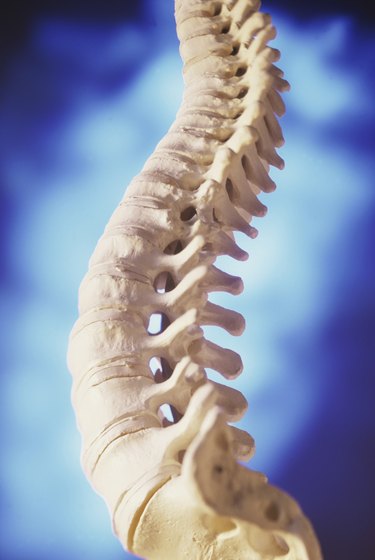
A compression fracture of the lumbar spine is also known as a wedge fracture. The lumbar area of the spine contains five vertebrae known as L1 through L5, situated between the thoracic or chest area and the buttocks. The lowest lumbar vertebra is situated just above the sacrum, or triangular bony plate that extends from the hip line to the middle of the buttocks. A number of bones and tissues make up each vertebra, including intervertebral discs that act as shock absorbers; the "bumps" in the spine, called transverse processes; and lamina, which protect the spinal canal.
Definition
Video of the Day
A lumbar compression fracture is located in the lower portion of the spine. Compression fractures are caused by pressure placed against the vertebrae due to lack of disc cushioning between the spinal bones, often caused by conditions like arthritis and osteoporosis. As bones in the spinal column grow weaker or collapse due to disease or injury, they compress against other bones, nerves and tissues, causing limited movement and range of motion, pain and numbness. Following a compression fracture in the spine, patients are often instructed to wear a brace for 6 to 12 weeks, followed by supervised physical therapy exercise.
Video of the Day
Low-Impact Exercise
Low-impact aerobic exercise like walking may be suggested by your physical therapist, but will depend on your progress and prognosis following injury or pain as well as what caused the compression fracture in the first place. Follow your physical therapist and doctor's instructions regarding resumption of any type of exercise following a compression fracture. Low-impact exercises such as walking, swimming and riding a bike can be performed tri-weekly, for 30 to 40 minutes maximum each time, depending on your strength and stamina.
Pelvis Stabilization
Following surgery for relief of lumbar fracture compression injury or trauma, your doctor may suggest short-arc exercises that promote flexion and extension of the quadriceps, such as pelvic stabilization exercises like the pelvic clock, says spine surgeon Dr. Matthew Cubbage. Pelvic clocks are done lying down and are broken down into four major points of a clock face -- 12, 6, 3 and 9. The hip bones are lifted or tilted downward or shifted from right to left in a clockwise direction as directed by your physical therapist.
Stretching
Stretching helps promote healing of injured bone, ligaments and tissues and may help relieve pain in the lower back caused by a compression fracture or following surgery. A simple yet effective stretching exercise for the lumbar spine is to sit on the floor, legs outstretched in front of you. Keep your back straight and your chest lifted, and then lean slightly forward with your upper torso. Place your hands on your thighs, your knees or your shins, depending on your flexibility and pain level, and as guided by your physical therapist. Do not bounce. Hold your stretches for 30 seconds and then relax.
- University of Maryland Medical Center; A Patient's Guide to Anatomy and Function of the Spine; Sept. 28, 2007
- Spine Universe; Compression and Wedge Fractures: Treatment and Recovery; Thomas A. Zdeblick, MD; Dec. 10, 2009
- Spine-Health; Physical Therapy Benefits for Back Pain; Peter F. Ullrich, Jr., MD; Sept. 8, 1999
- Matthew P. Cubbage, MD: Spinal Surgery
- Michigan State University: Pelvic Clock